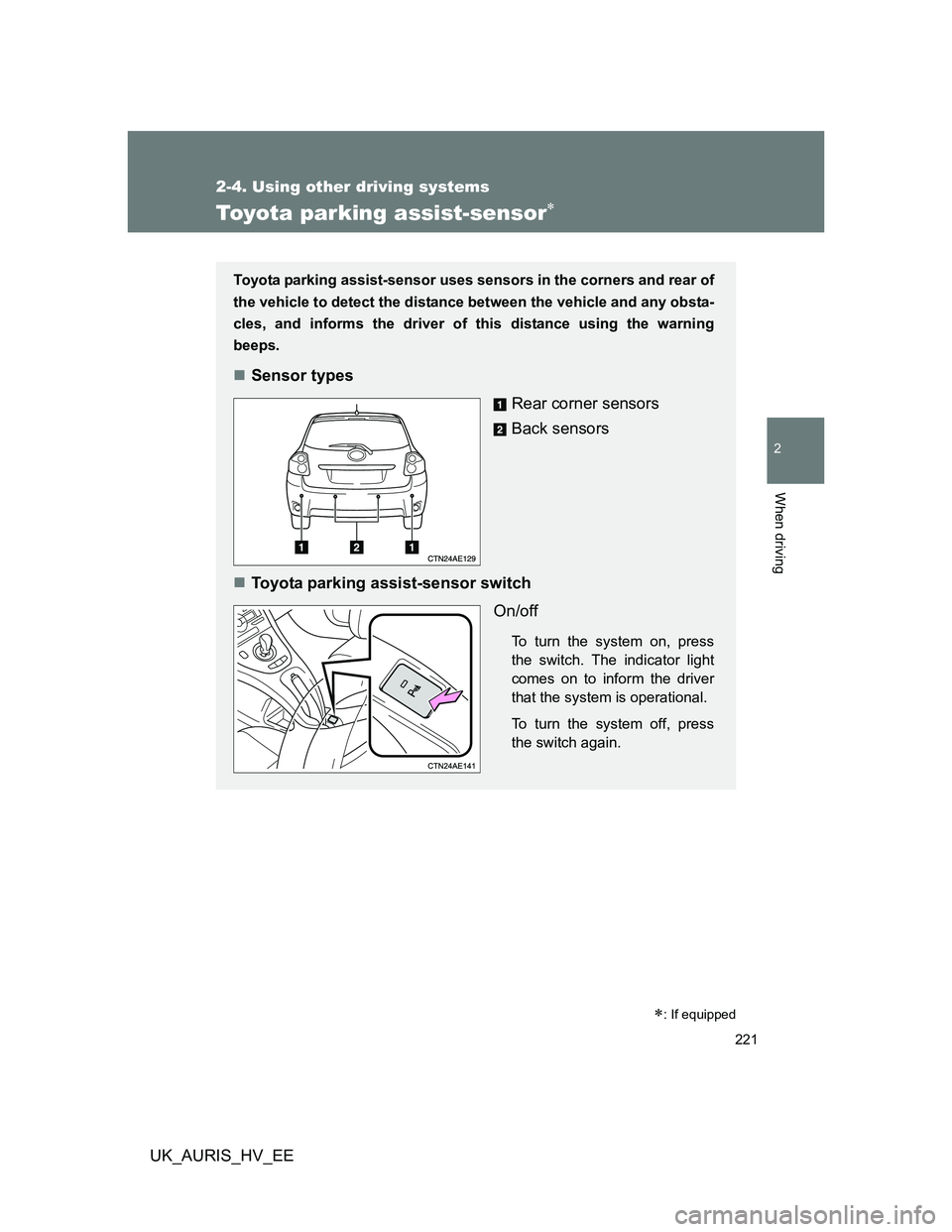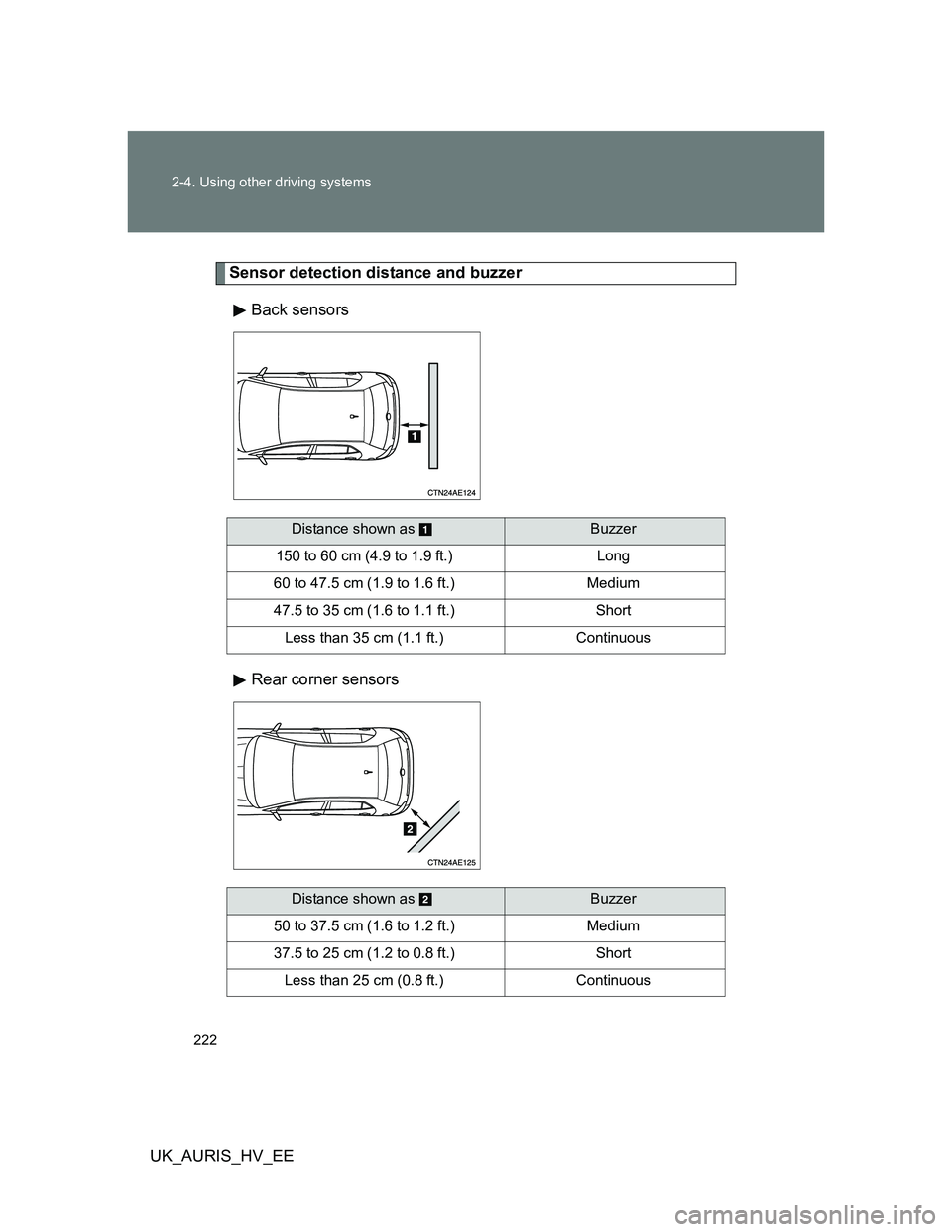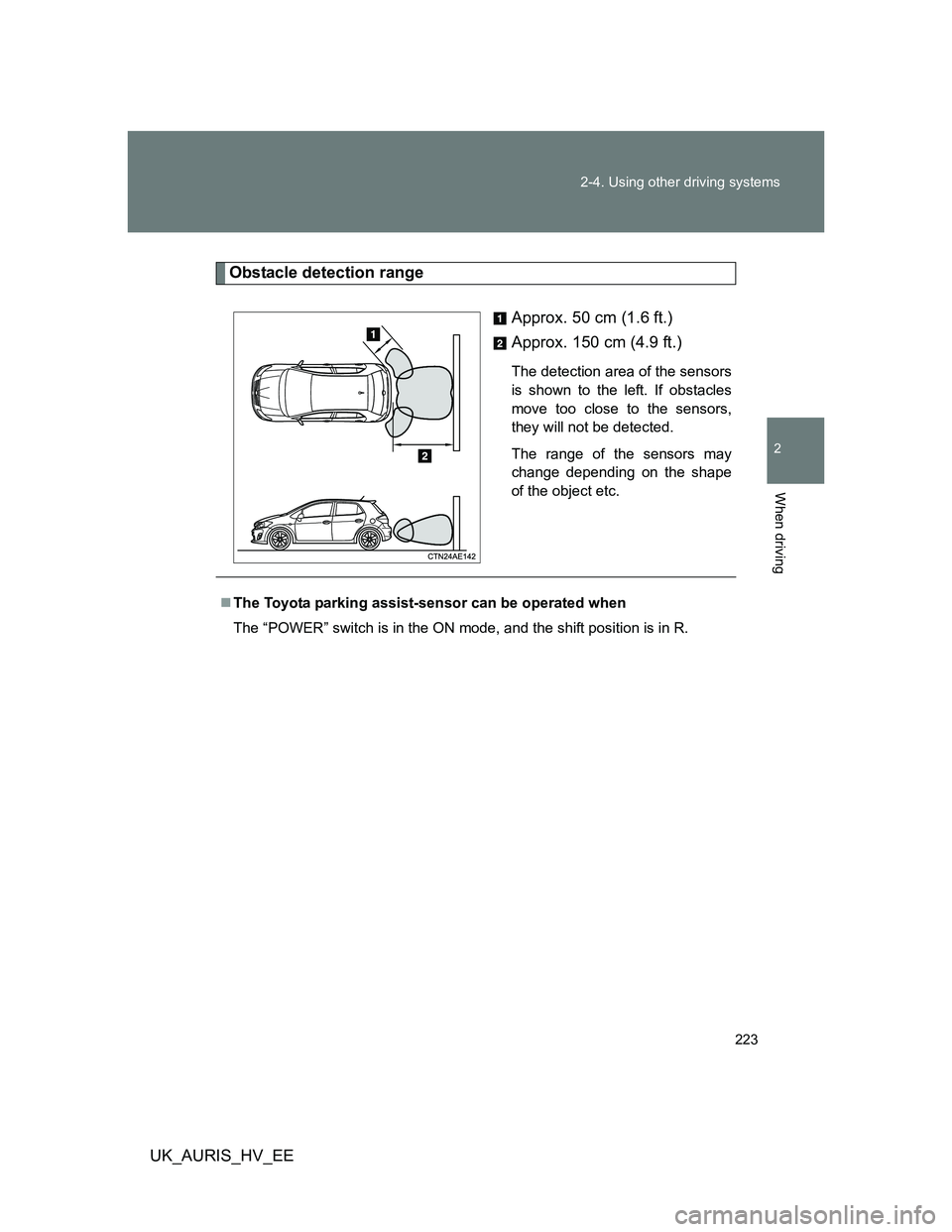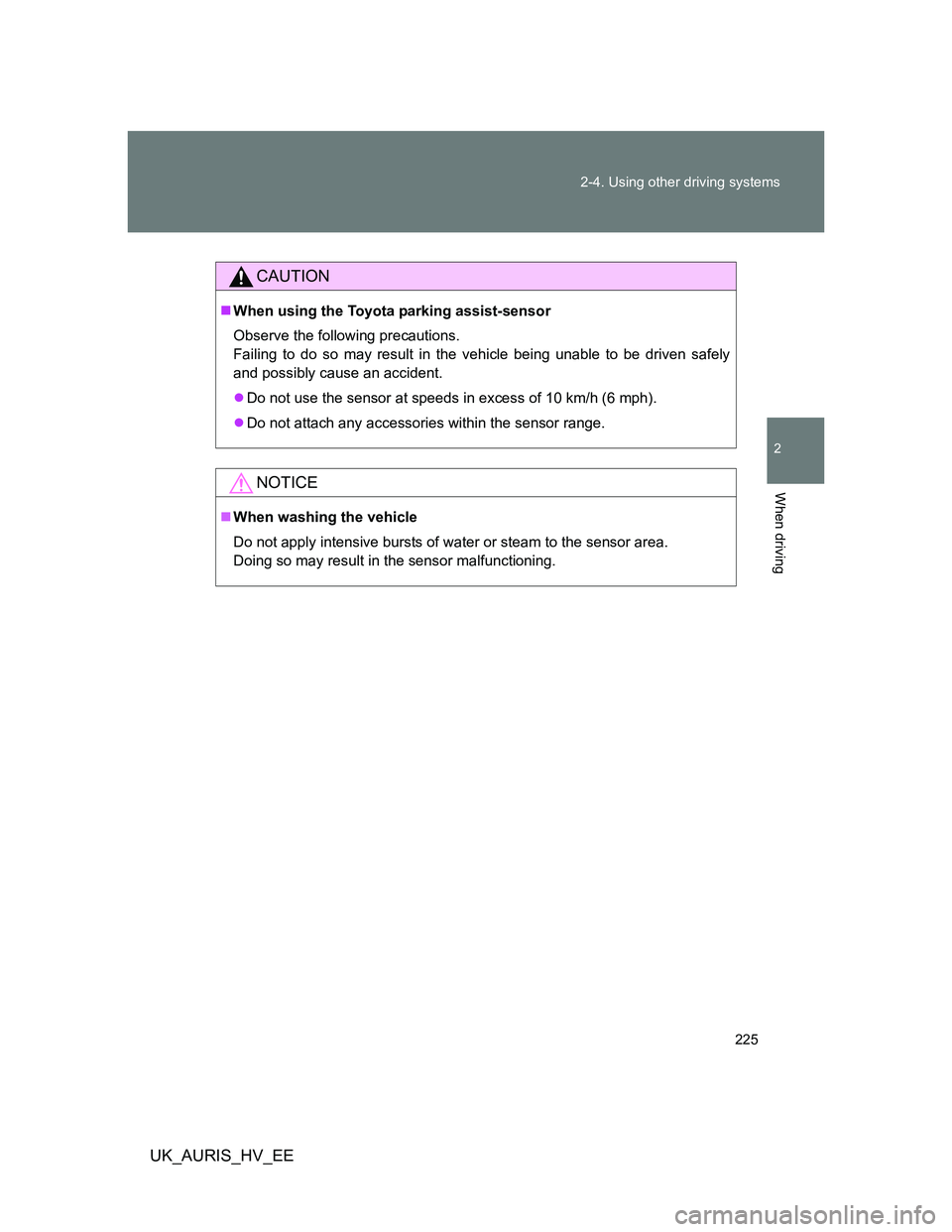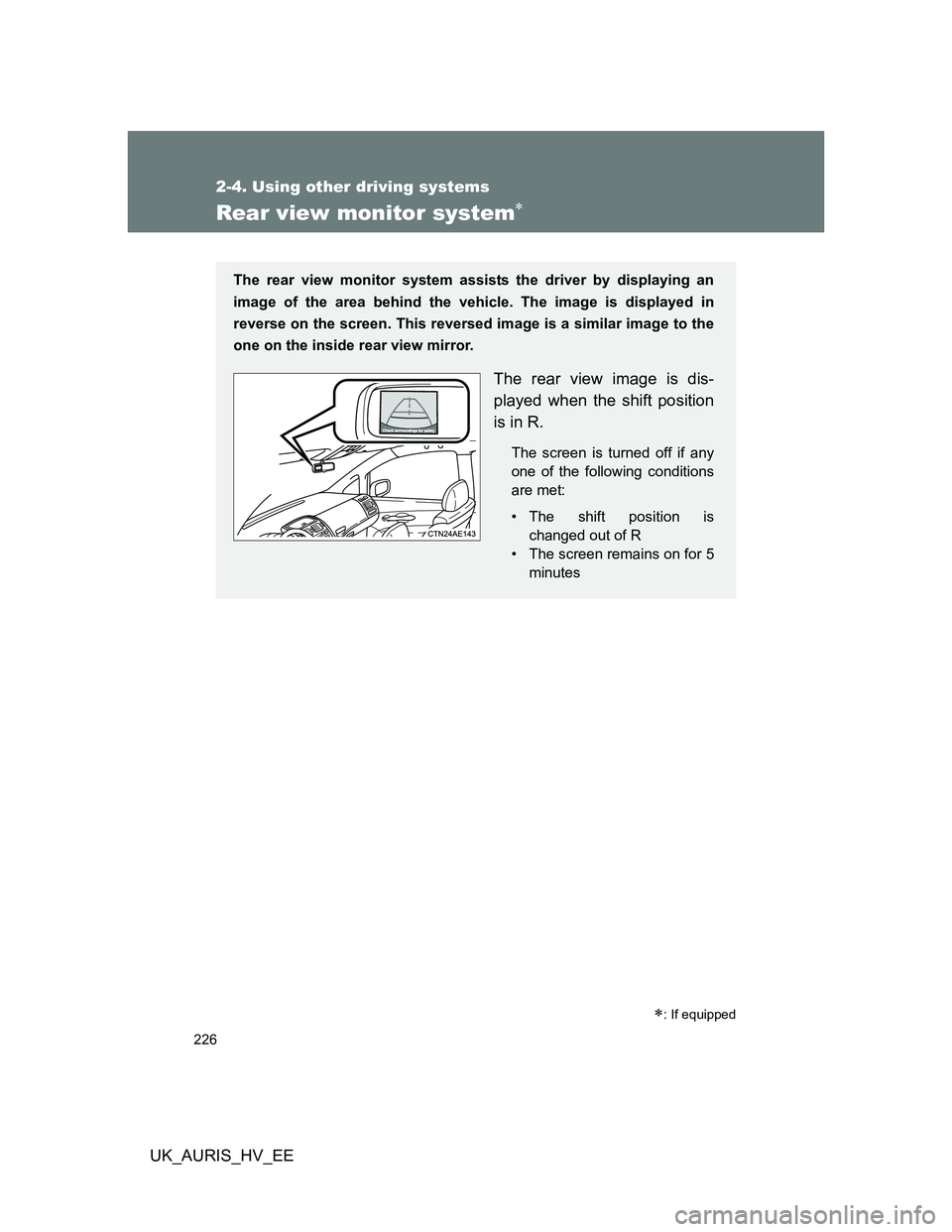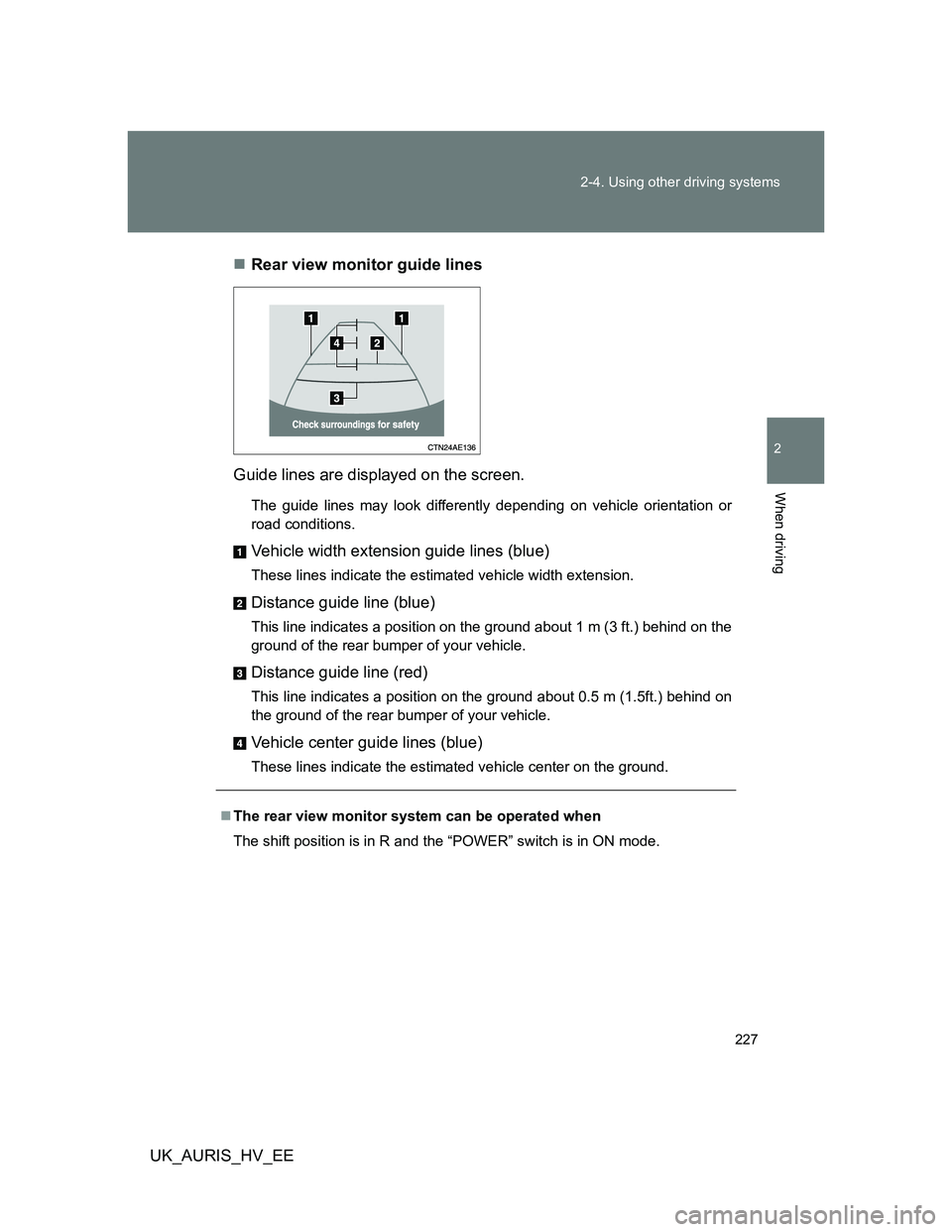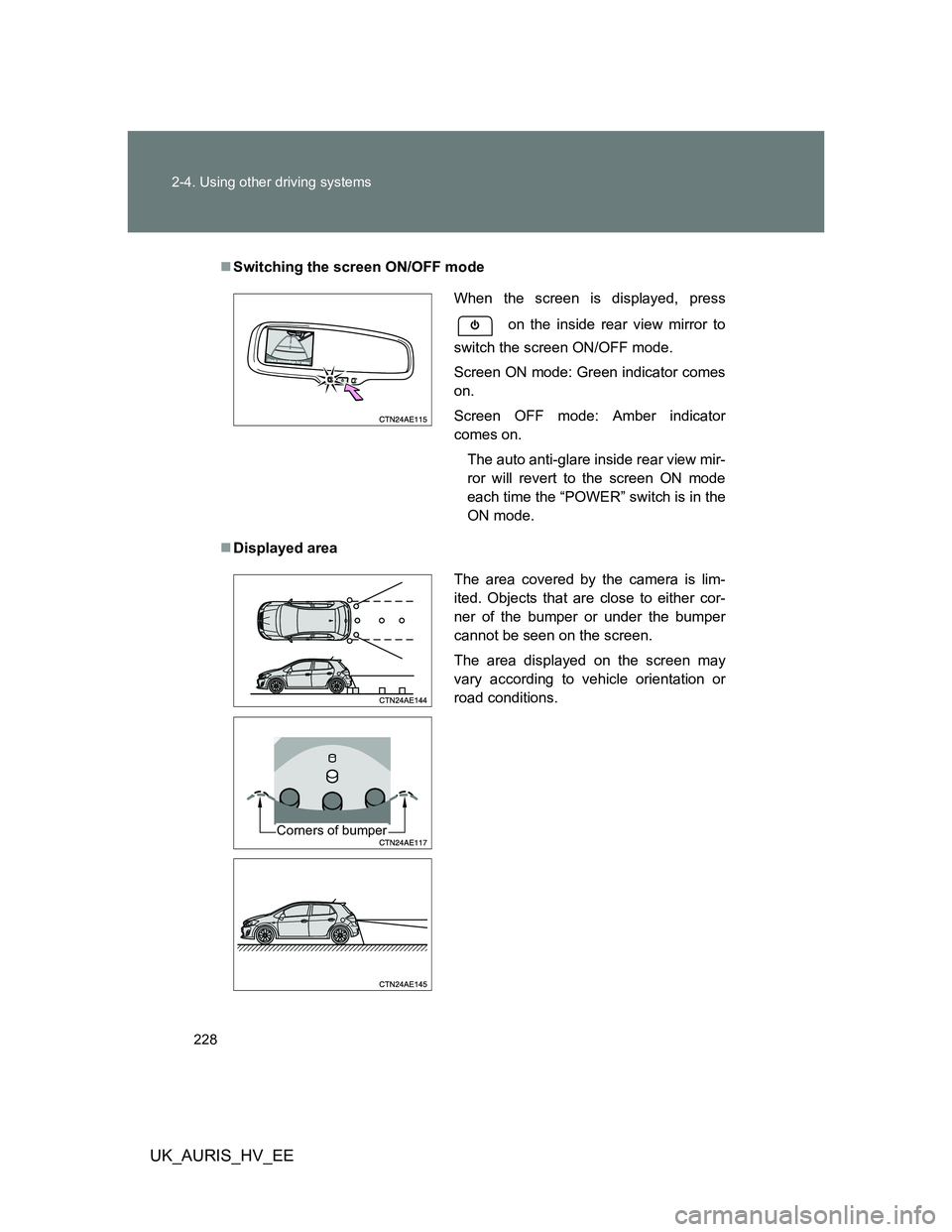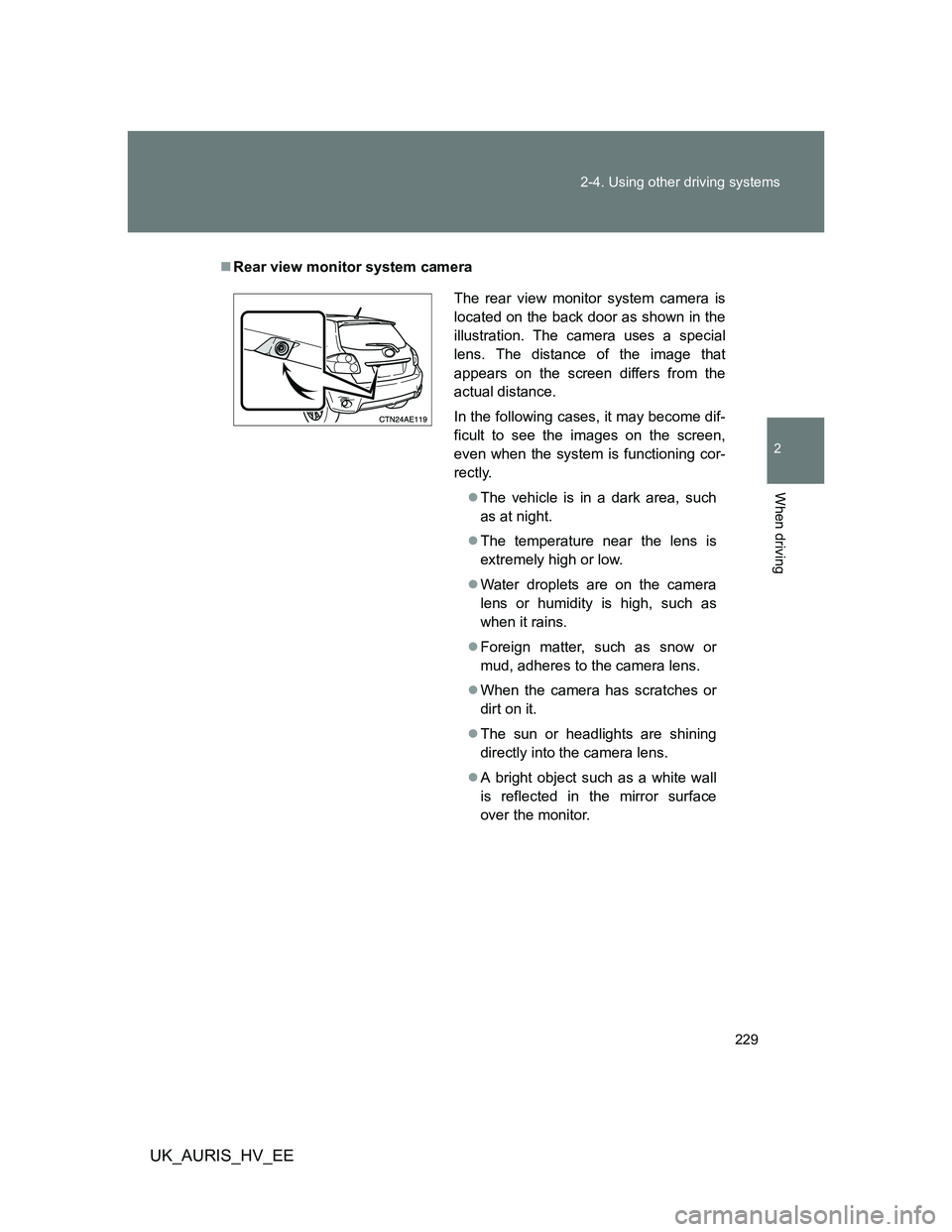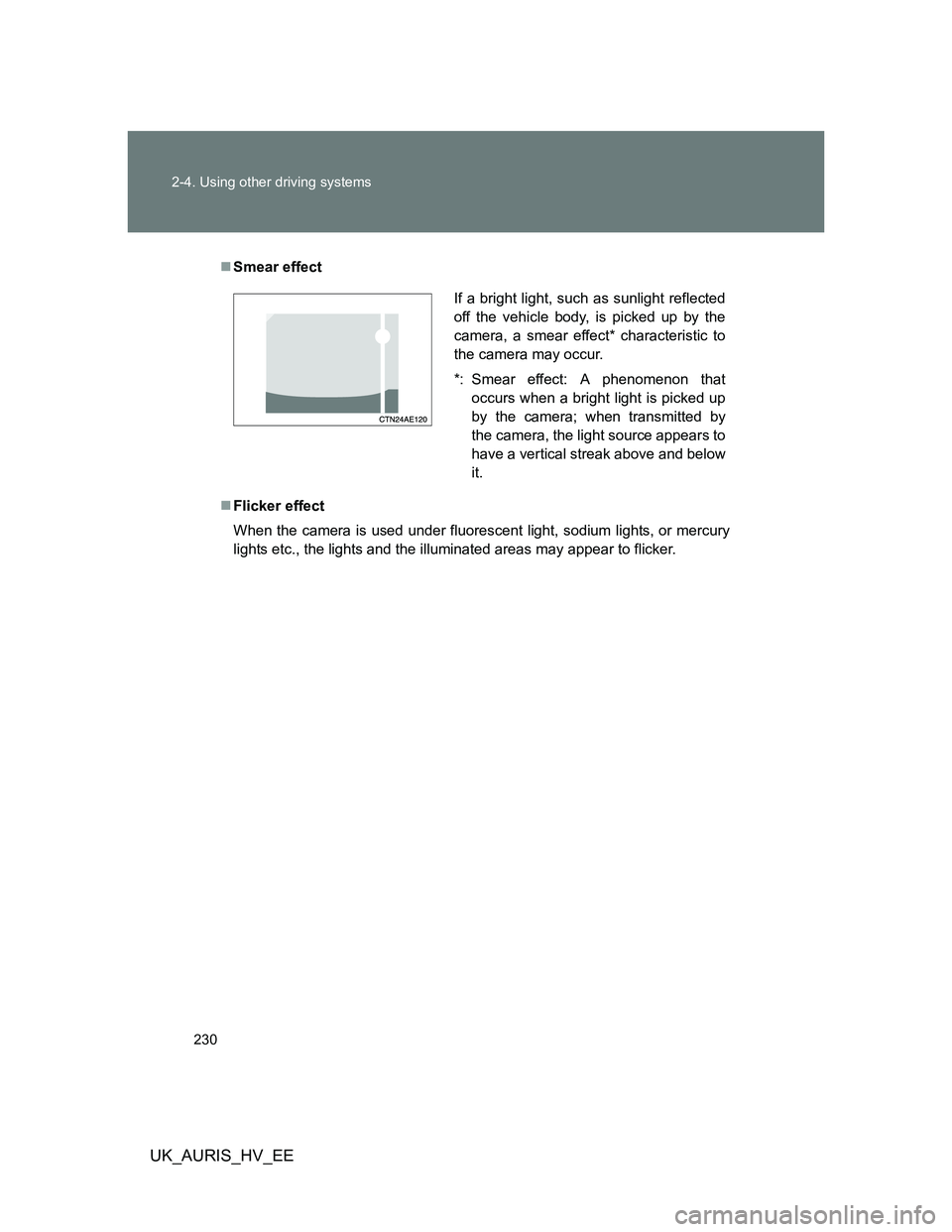TOYOTA AURIS 2011 Owners Manual (in English)
AURIS 2011
TOYOTA
TOYOTA
https://www.carmanualsonline.info/img/14/48270/w960_48270-0.png
TOYOTA AURIS 2011 Owners Manual (in English)
Trending: engine, oil filter, alarm, fuel filter, engine coolant, radiator, maintenance schedule
Page 221 of 524
221
2-4. Using other driving systems
2
When driving
UK_AURIS_HV_EE
Toyota parking assist-sensor
: If equipped
Toyota parking assist-sensor uses sensors in the corners and rear of
the vehicle to detect the distance between the vehicle and any obsta-
cles, and informs the driver of this distance using the warning
beeps.
Sensor types
Rear corner sensors
Back sensors
Toyota parking assist-sensor switch
On/off
To turn the system on, press
the switch. The indicator light
comes on to inform the driver
that the system is operational.
To turn the system off, press
the switch again.
Page 222 of 524
222 2-4. Using other driving systems
UK_AURIS_HV_EE
Sensor detection distance and buzzer
Back sensors
Rear corner sensors
Distance shown as Buzzer
150 to 60 cm (4.9 to 1.9 ft.) Long
60 to 47.5 cm (1.9 to 1.6 ft.) Medium
47.5 to 35 cm (1.6 to 1.1 ft.) Short
Less than 35 cm (1.1 ft.) Continuous
Distance shown as Buzzer
50 to 37.5 cm (1.6 to 1.2 ft.) Medium
37.5 to 25 cm (1.2 to 0.8 ft.) Short
Less than 25 cm (0.8 ft.) Continuous
Page 223 of 524
223 2-4. Using other driving systems
2
When driving
UK_AURIS_HV_EE
Obstacle detection range
Approx. 50 cm (1.6 ft.)
Approx. 150 cm (4.9 ft.)
The detection area of the sensors
is shown to the left. If obstacles
move too close to the sensors,
they will not be detected.
The range of the sensors may
change depending on the shape
of the object etc.
The Toyota parking assist-sensor can be operated when
The “POWER” switch is in the ON mode, and the shift position is in R.
Page 224 of 524
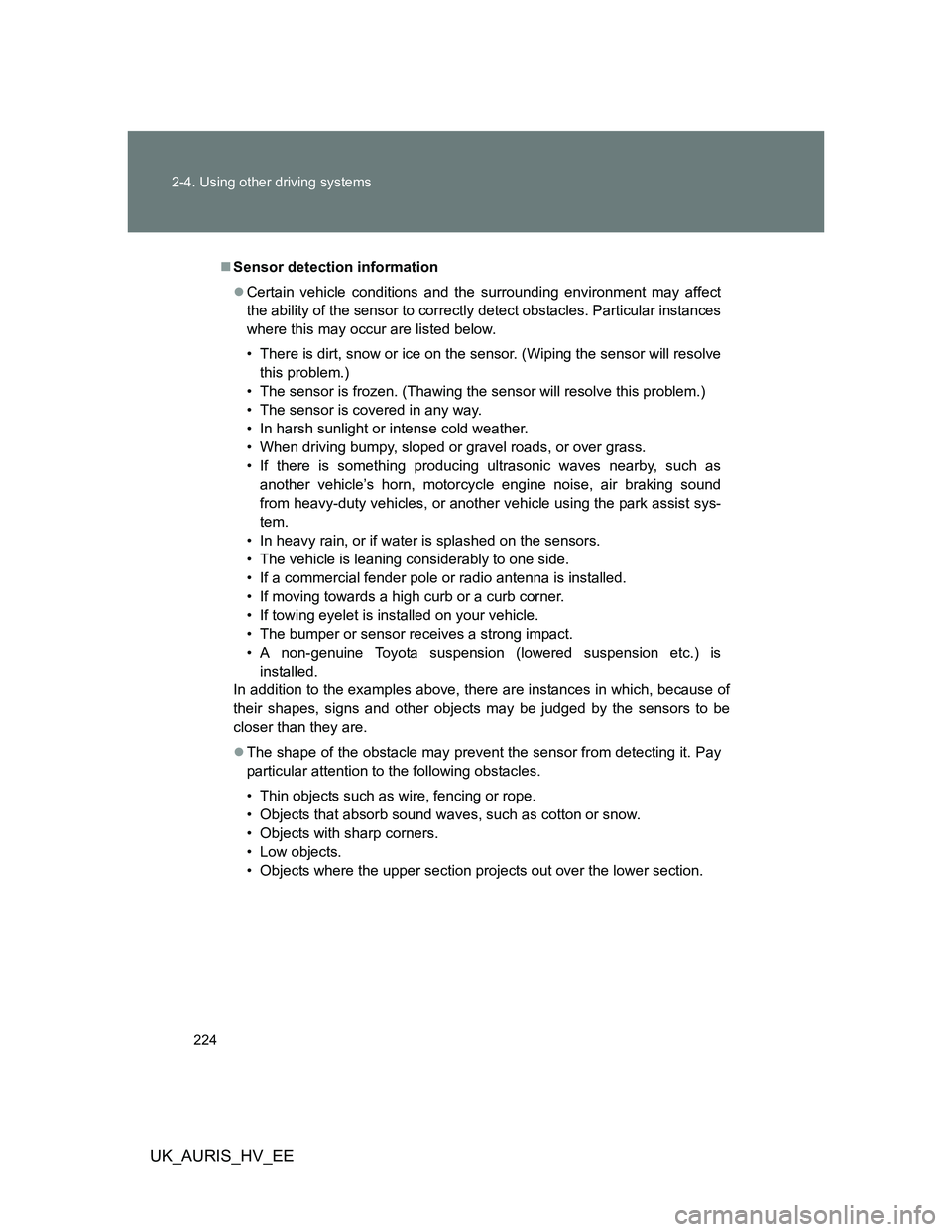
224 2-4. Using other driving systems
UK_AURIS_HV_EE
Sensor detection information
Certain vehicle conditions and the surrounding environment may affect
the ability of the sensor to correctly detect obstacles. Particular instances
where this may occur are listed below.
• There is dirt, snow or ice on the sensor. (Wiping the sensor will resolve
this problem.)
• The sensor is frozen. (Thawing the sensor will resolve this problem.)
• The sensor is covered in any way.
• In harsh sunlight or intense cold weather.
• When driving bumpy, sloped or gravel roads, or over grass.
• If there is something producing ultrasonic waves nearby, such as
another vehicle’s horn, motorcycle engine noise, air braking sound
from heavy-duty vehicles, or another vehicle using the park assist sys-
tem.
• In heavy rain, or if water is splashed on the sensors.
• The vehicle is leaning considerably to one side.
• If a commercial fender pole or radio antenna is installed.
• If moving towards a high curb or a curb corner.
• If towing eyelet is installed on your vehicle.
• The bumper or sensor receives a strong impact.
• A non-genuine Toyota suspension (lowered suspension etc.) is
installed.
In addition to the examples above, there are instances in which, because of
their shapes, signs and other objects may be judged by the sensors to be
closer than they are.
The shape of the obstacle may prevent the sensor from detecting it. Pay
particular attention to the following obstacles.
• Thin objects such as wire, fencing or rope.
• Objects that absorb sound waves, such as cotton or snow.
• Objects with sharp corners.
• Low objects.
• Objects where the upper section projects out over the lower section.
Page 225 of 524
225 2-4. Using other driving systems
2
When driving
UK_AURIS_HV_EE
CAUTION
When using the Toyota parking assist-sensor
Observe the following precautions.
Failing to do so may result in the vehicle being unable to be driven safely
and possibly cause an accident.
Do not use the sensor at speeds in excess of 10 km/h (6 mph).
Do not attach any accessories within the sensor range.
NOTICE
When washing the vehicle
Do not apply intensive bursts of water or steam to the sensor area.
Doing so may result in the sensor malfunctioning.
Page 226 of 524
226
2-4. Using other driving systems
UK_AURIS_HV_EE
Rear view monitor system
: If equipped
The rear view monitor system assists the driver by displaying an
image of the area behind the vehicle. The image is displayed in
reverse on the screen. This reversed image is a similar image to the
one on the inside rear view mirror.
The rear view image is dis-
played when the shift position
is in R.
The screen is turned off if any
one of the following conditions
are met:
• The shift position is
changed out of R
• The screen remains on for 5
minutes
Page 227 of 524
227 2-4. Using other driving systems
2
When driving
UK_AURIS_HV_EERear view monitor guide lines
Guide lines are displayed on the screen.
The guide lines may look differently depending on vehicle orientation or
road conditions.
Vehicle width extension guide lines (blue)
These lines indicate the estimated vehicle width extension.
Distance guide line (blue)
This line indicates a position on the ground about 1 m (3 ft.) behind on the
ground of the rear bumper of your vehicle.
Distance guide line (red)
This line indicates a position on the ground about 0.5 m (1.5ft.) behind on
the ground of the rear bumper of your vehicle.
Vehicle center guide lines (blue)
These lines indicate the estimated vehicle center on the ground.
The rear view monitor system can be operated when
The shift position is in R and the “POWER” switch is in ON mode.
Page 228 of 524
228 2-4. Using other driving systems
UK_AURIS_HV_EE
Switching the screen ON/OFF mode
Displayed area
When the screen is displayed, press
on the inside rear view mirror to
switch the screen ON/OFF mode.
Screen ON mode: Green indicator comes
on.
Screen OFF mode: Amber indicator
comes on.
The auto anti-glare inside rear view mir-
ror will revert to the screen ON mode
each time the “POWER” switch is in the
ON mode.
The area covered by the camera is lim-
ited. Objects that are close to either cor-
ner of the bumper or under the bumper
cannot be seen on the screen.
The area displayed on the screen may
vary according to vehicle orientation or
road conditions.
Corners of bumper
Page 229 of 524
229 2-4. Using other driving systems
2
When driving
UK_AURIS_HV_EE
Rear view monitor system camera
The rear view monitor system camera is
located on the back door as shown in the
illustration. The camera uses a special
lens. The distance of the image that
appears on the screen differs from the
actual distance.
In the following cases, it may become dif-
ficult to see the images on the screen,
even when the system is functioning cor-
rectly.
The vehicle is in a dark area, such
as at night.
The temperature near the lens is
extremely high or low.
Water droplets are on the camera
lens or humidity is high, such as
when it rains.
Foreign matter, such as snow or
mud, adheres to the camera lens.
When the camera has scratches or
dirt on it.
The sun or headlights are shining
directly into the camera lens.
A bright object such as a white wall
is reflected in the mirror surface
over the monitor.
Page 230 of 524
230 2-4. Using other driving systems
UK_AURIS_HV_EE
Smear effect
Flicker effect
When the camera is used under fluorescent light, sodium lights, or mercury
lights etc., the lights and the illuminated areas may appear to flicker.
If a bright light, such as sunlight reflected
off the vehicle body, is picked up by the
camera, a smear effect* characteristic to
the camera may occur.
*: Smear effect: A phenomenon that
occurs when a bright light is picked up
by the camera; when transmitted by
the camera, the light source appears to
have a vertical streak above and below
it.
Trending: warning lights, charging, battery location, wiper blades, fuel consumption, transmission fluid, reset
